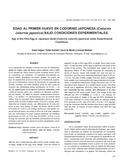| dc.rights.license | http://creativecommons.org/licenses/by-nc-sa/3.0/ve/ | |
| dc.contributor.author | Vargas, Daniel | |
| dc.contributor.author | Galíndez, Rafael | |
| dc.contributor.author | De Basilio, Vasco | |
| dc.contributor.author | Martínez García, Gonzalo | |
| dc.date.accessioned | 2009-05-12T22:13:12Z | |
| dc.date.available | 2009-05-12T22:13:12Z | |
| dc.date.issued | 2009-05-12T22:13:12Z | |
| dc.identifier.issn | 0798-2259 | es_VE |
| dc.identifier.uri | http://www.saber.ula.ve/handle/123456789/28225 | |
| dc.description.abstract | Con el propósito de estudiar el efecto del mes de nacimiento, granja de origen, peso del huevo, peso corporal, color y brillo de la cáscara del huevo sobre la edad al primer huevo (EPH) en codornices, se evaluaron 115 hembras provenientes de huevos fértiles adquiridos en cuatro granjas del centro del país. El experimento se llevó a cabo en la Facultad de Agronomía de la Universidad Central de Venezuela en galpones de 4mx4m, cerrados con malla metálica, techo de zinc y piso de cemento que albergaban jaulas individuales de 50 cm. × 20 cm. Se registró peso de los huevos, fecha de nacimiento, color y brillo de huevos, peso vivo, consumo de alimento y producción de huevos. Se utilizó un diseño completamente aleatorizado, y se analizó 115 observaciones con un modelo lineal aditivo. Sólo se encontró efecto significativo del mes de nacimiento sobre la edad al primer huevo (P=0,001), siendo abril y diciembre los mejores meses, con diferencias de 40 días respecto al peor mes (junio). El peso del huevo afectó la EPH (P=0,0022; b=–4,46 ± 1,42 días/g), donde por cada gramo extra de peso del huevo se redujo la EPH en 4,46 días, mientras que por cada gramo de peso corporal adicional, las hembras incrementan su EPH en 0,52 días (P=0,0001, b=0,52 ± 0,07 días/g). Se concluye que las hembras provenientes de huevos pesados y que nacen en meses de menor precipitación, resultan más precoces. | es_VE |
| dc.language.iso | es | es_VE |
| dc.rights | info:eu-repo/semantics/openAccess | |
| dc.subject | Madurez sexual | es_VE |
| dc.subject | Peso del huevo | es_VE |
| dc.subject | Color de la cáscara del huevo | es_VE |
| dc.subject | Brillo del huevo | es_VE |
| dc.subject | Coturnix coturnix japonica | es_VE |
| dc.title | Edad al primer huevo en codorniz japonesa (Coturnix coturnix japonica) bajo condiciones experimentales | es_VE |
| dc.title.alternative | Age at the first egg in japanese quail (Coturnix coturnix japonica) under experimental conditions | es_VE |
| dc.type | info:eu-repo/semantics/article | |
| dc.description.abstract1 | With the aim of determine the effect of the month of birth, farm of origin, weight of the egg, body weight, color and sheen of eggshell on age at first egg (AFE) in quails, there were evaluated 115 females from fertile eggs acquired in four farms of the center of the country. The experiment was carried out in the Agronomy School of the Central University of Venezuela in sheds of 4mx4m, closed with metallic net, zinc roof and cement floor, and they were sheltering individual cages of 50 cm. × 20 cm. The date of birth, weight, color and sheen of eggshell, body weight, food consumption and egg production were registered. A completely randomized design was used, and 115 observations were analyzed by a additive linear model. Only birth month had a significant (P=0.001) effect on AFE, being April and December the best months, with differences of 40 days with regard to the worst month (June). The weight of the egg affected the EPH (P=0.0022; b =–4.46 ± 1.42 days/g), for every extra gram of weight of the egg the EPH diminished in 4.46 days; whereas for every extra gram of corporal weight, EFH increase in 0.52 days (P=0.0001, b=0.52 ± 0.07 days/g). It can be concluded that the females from heavy eggs and that they are born in months of minor rainfall, had their first egg early in life. | es_VE |
| dc.description.colacion | 181-186 | es_VE |
| dc.description.email | vargasd@agr.ucv.ve | es_VE |
| dc.description.frecuencia | Bimestral | es_VE |
| dc.identifier.depositolegal | 199102ZU46 | es_VE |
| dc.subject.institucion | Universidad del Zulia (LUZ) | es_VE |
| dc.subject.institucion | Universidad de Los Andes (ULA) | es_VE |
| dc.subject.keywords | Sexual maturity | es_VE |
| dc.subject.keywords | Egg weight | es_VE |
| dc.subject.keywords | Eggshell color | es_VE |
| dc.subject.keywords | Eggshell sheen | es_VE |
| dc.subject.keywords | Coturnix coturnix japonica | es_VE |
| dc.subject.publicacionelectronica | Revista Científica | es_VE |
| dc.subject.seccion | Revista Científica: Medicina Veterinaria | es_VE |
| dc.subject.thematiccategory | Medio Ambiente | es_VE |
| dc.subject.tipo | Revistas | es_VE |
| dc.type.media | Texto | es_VE |



